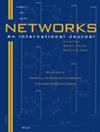自适应预算影响最大化问题的数学强化学习
IF 1.3
4区 计算机科学
Q4 COMPUTER SCIENCE, HARDWARE & ARCHITECTURE
引用次数: 0
摘要
在社交网络中,影响力最大化问题要求选择一组初始节点来施加影响,从而使影响力的传播在某些扩散模型下达到最大。通常,该问题以两阶段无预算方式提出:决策者选择一定数量的节点施加影响,然后观察结果。在该问题的自适应版本中,可以在给定时间间隔的每个时间步选择节点。这样,决策者就可以利用对传播的观察,做出更好的决策。本文考虑的是自适应预算影响最大化问题,即决策者有有限预算来影响节点,而每个节点都需要付出一定代价才能被影响的自适应问题。我们提出了两种解决方法:第一种是利用混合整数线性问题的近似值迭代,第二种是利用图神经网络的新概念。大量的数值实验证明了所提方法的有效性。本文章由计算机程序翻译,如有差异,请以英文原文为准。
Math-based reinforcement learning for the adaptive budgeted influence maximization problem
In social networks, the influence maximization problem requires selecting an initial set of nodes to influence so that the spread of influence can reach its maximum under certain diffusion models. Usually, the problem is formulated in a two-stage un-budgeted fashion: The decision maker selects a given number of nodes to influence and observes the results. In the adaptive version of the problem, it is possible to select the nodes at each time step of a given time interval. This allows the decision-maker to exploit the observation of the propagation and to make better decisions. This paper considers the adaptive budgeted influence maximization problem, that is, the adaptive problem in which the decision maker has a finite budget to influence the nodes, and each node requires a cost to be influenced. We present two solution techniques: The first is an approximated value iteration leveraging mixed integer linear problems while the second exploits new concepts from graph neural networks. Extensive numerical experiments demonstrate the effectiveness of the proposed approaches.
求助全文
通过发布文献求助,成功后即可免费获取论文全文。
去求助
来源期刊

Networks
工程技术-计算机:硬件
CiteScore
4.40
自引率
9.50%
发文量
46
审稿时长
12 months
期刊介绍:
Network problems are pervasive in our modern technological society, as witnessed by our reliance on physical networks that provide power, communication, and transportation. As well, a number of processes can be modeled using logical networks, as in the scheduling of interdependent tasks, the dating of archaeological artifacts, or the compilation of subroutines comprising a large computer program. Networks provide a common framework for posing and studying problems that often have wider applicability than their originating context.
The goal of this journal is to provide a central forum for the distribution of timely information about network problems, their design and mathematical analysis, as well as efficient algorithms for carrying out optimization on networks. The nonstandard modeling of diverse processes using networks and network concepts is also of interest. Consequently, the disciplines that are useful in studying networks are varied, including applied mathematics, operations research, computer science, discrete mathematics, and economics.
Networks publishes material on the analytic modeling of problems using networks, the mathematical analysis of network problems, the design of computationally efficient network algorithms, and innovative case studies of successful network applications. We do not typically publish works that fall in the realm of pure graph theory (without significant algorithmic and modeling contributions) or papers that deal with engineering aspects of network design. Since the audience for this journal is then necessarily broad, articles that impact multiple application areas or that creatively use new or existing methodologies are especially appropriate. We seek to publish original, well-written research papers that make a substantive contribution to the knowledge base. In addition, tutorial and survey articles are welcomed. All manuscripts are carefully refereed.
 求助内容:
求助内容: 应助结果提醒方式:
应助结果提醒方式:


